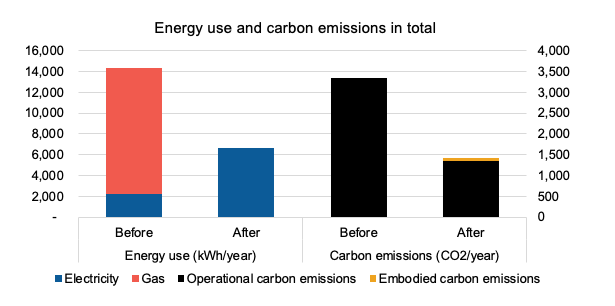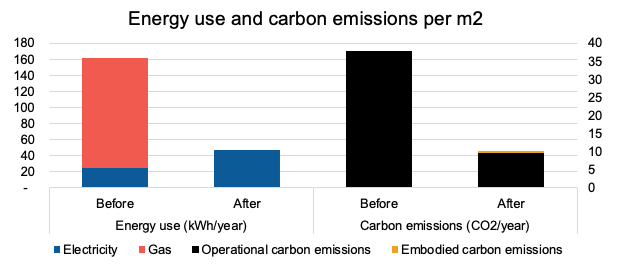A year ago, I announced that we had replaced our six-year-old, reliable gas boiler with an air source heat pump. “Ripping out a perfectly well functioning gas boiler before the end of its natural life and replacing it with a heat pump is misguided. It won’t reduce much carbon,” I was told.
“Let’s find out,” I thought, and estimated the carbon savings we could expect. All of this was based on probabilities and benchmarks from previous studies. People have asked me many times about the actual impact and how it compares to my estimate from a year ago.
Savings
The gas boiler in our house in the UK used about 12.1 megawatt-hours (MWh) of gas a year. According to the meter, the heat pump used around 4.4 MWh of electricity. Factoring in the 2.2 MWh of electricity not used for heating, we reduced our energy use by 54%, fairly close to the 60% reduction I predicted in 2019.

When we installed the heat pump, however, we also enlarged our house from 89 square metres to 140 square metres. Based on the floor area, we actually used 71% less energy.

The carbon savings are more difficult to calculate.
Previously, I used the marginal emissions factor, a number that is used for calculating carbon emissions from small changes in electricity demand. For 2020, the UK has established a marginal emissions factor of 296 grams of CO2/kWh for the domestic sector.
Using the marginal emissions factor, though, could be too conservative. We run our heat pump in such a way that it avoids the peak hours from 4:00 p.m. to 7:00 p.m. Emissions are highest during peak hours, when additional and often more carbon-intensive generation is used to produce electricity. This means it is not only important how much electricity we use, but it also increasingly matters when we use it.
National Grid, the UK’s transmission system operator, provides half-hourly figures for the carbon emissions per kilowatt-hour generated in different parts of the UK. These can be used to calculate the carbon emissions from using electricity more accurately than using an average marginal emissions factor.
Luckily, we have a smart meter that allows us to track our electricity use also in half-hourly intervals. Based on when we used electricity and how much, I estimate the actual carbon emissions for heating our home was closer to 204 grams of CO2/kWh.
So how much carbon have we saved? Based on the figures above, I calculate savings between 46% using the marginal emissions factor, and 58% using the half-hourly emission factors from National Grid. Per square metre of floor area, the savings range from 66% to 73%.
Costs
Initially, our costs stayed about the same, but we have since switched to an “agile” tariff from UK provider Octopus Energy that changes every 30 minutes. This means our electricity is more expensive during peak hours. By using an app, which tracks the lowest tariffs, we can schedule our heat pump to avoid operating during peak times. As a result, our electricity prices average around £0.07/kWh (€0.078/kWh), less than half of what we previously paid.
Each year, we now pay about £500 (€557.47) for all of our energy needs, 60% less than the £1,200 (€1,338) we paid before. Per square metre, we have seen 74% reduction in energy costs.
Adding in the payments of the Renewable Heat Incentive, a financial support programme by the UK government, it should only take ten years to recoup the outlay for the heat pump entirely, whilst we will continue to benefit from much lower energy bills.
Life with a heat pump
Using a heat pump over a gas-powered boiler is different in so many ways, mainly for the better. Previously, on a cold day, we turned the heating on in the morning and the house was warm after about 30 minutes. With the heat pump, the temperature of the water in the pipes is a lot lower, which allows it to operate more efficiently but this means it takes longer to change the temperature from cold to warm.
Yet, rather than having to worry about when to turn on the heating, we tell the system what temperature we want and when. Our app works out the cheapest way of meeting that temperature and operates the heat pump accordingly. It took us a while to get used to these changes, but we now simply appreciate walking into our warm kitchen every morning.
A version of this article originally appeared in Foresight Climate & Energy.

